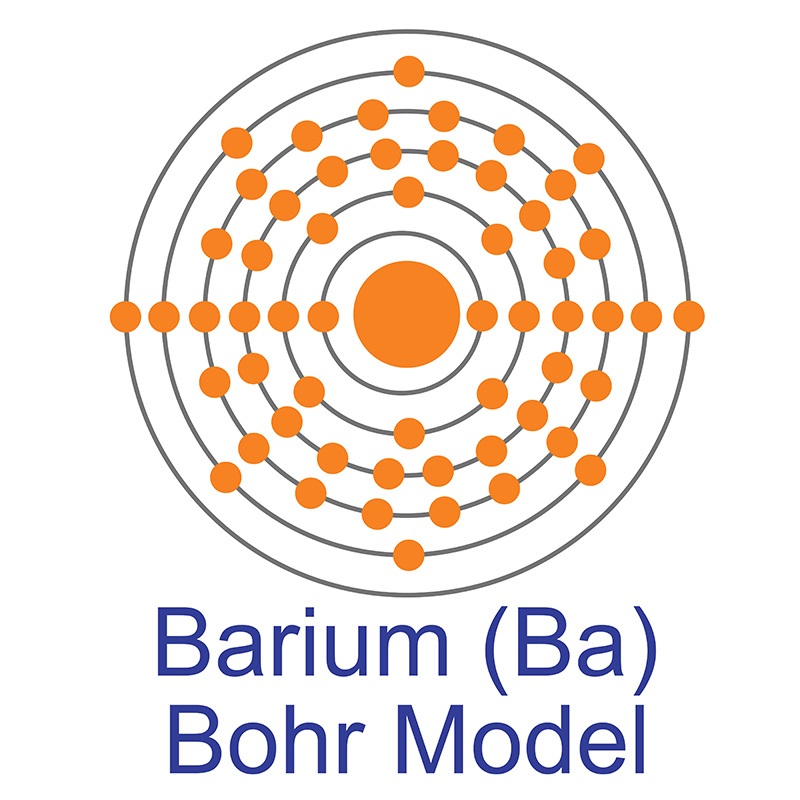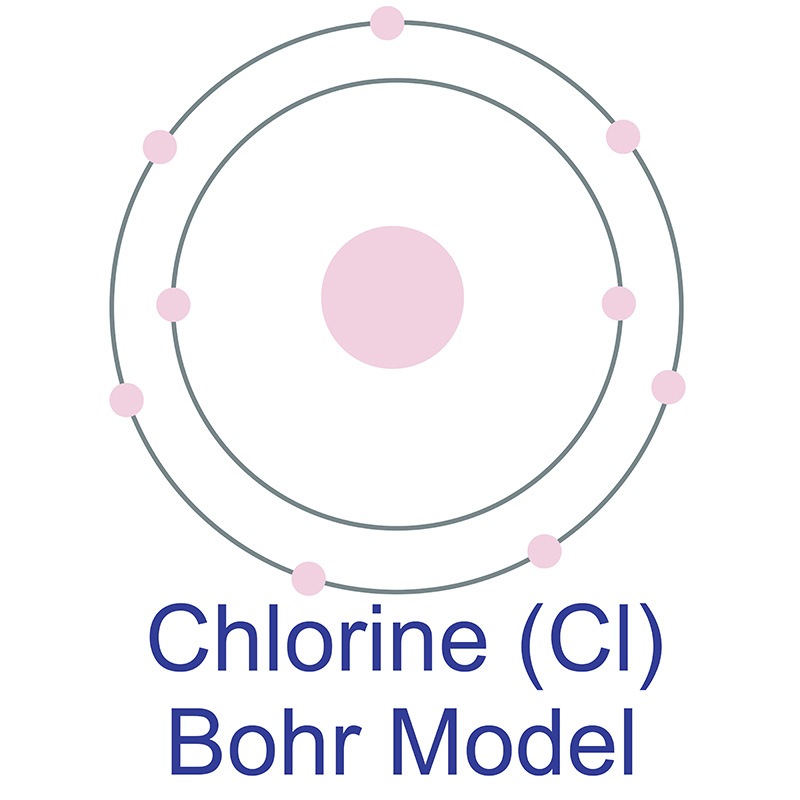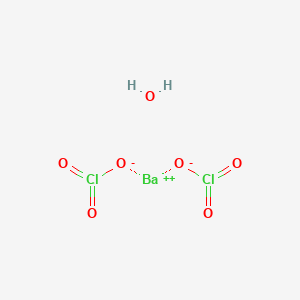SECTION 1. IDENTIFICATION
Product Name: Barium Chlorate Hydrate
Product Number: All applicable American Elements product codes, e.g. BA-CLT-01-C.XHYD
CAS #: 13477-00-4
Relevant identified uses of the substance: Scientific research and development
Supplier details:
American Elements
10884 Weyburn Ave.
Los Angeles, CA 90024
Tel: +1 310-208-0551
Fax: +1 310-208-0351
Emergency telephone number:
Domestic, North America: +1 800-424-9300
International: +1 703-527-3887
SECTION 2. HAZARDS IDENTIFICATION
Name 1) Barium Chlorate, Monohydrate
CAS # 10294-38-9
TWA (mg/m3) -
STEL (mg/m3) -
CEIL (mg/m3) -
% by Weight 100
Toxicological Data
on Ingredients
Barium Chlorate, Monohydrate
LD50: Not available.
LC50: Not available.
SECTION 3. COMPOSITION/INFORMATION ON INGREDIENTS
Potential Acute Health Effects Hazardous in case of skin contact (irritant), of eye contact (irritant), of ingestion. Slightly hazardous in case of inhalation. Prolonged exposure may result in skin burns and ulcerations. Over-exposure by inhalation may cause respiratory irritation.
Potential Chronic Health CARCINOGENIC EFFECTS: Not available.
Effects MUTAGENIC EFFECTS: Not available.
TERATOGENIC EFFECTS: Not available.
DEVELOPMENTAL TOXICITY: Not available.
The substance may be toxic to blood, kidneys, lungs.
Repeated or prolonged exposure to the substance can produce target organs damage.
SECTION 4. FIRST AID MEASURES
Eye Contact Check for and remove any contact lenses. In case of contact, immediately flush eyes with plenty of water for at least 15 minutes. Cold water may be used. Get medical attention.
Skin Contact In case of contact, immediately flush skin with plenty of water. Cover the irritated skin with an emollient. Remove contaminated clothing and shoes. Cold water may be used.Wash clothing before reuse. Thoroughly clean shoes before reuse. Get medical attention.
Serious Skin Contact Wash with a disinfectant soap and cover the contaminated skin with an anti-bacterial cream. Seek immediate medical attention.
Inhalation If inhaled, remove to fresh air. If not breathing, give artificial respiration. If breathing is difficult, give oxygen. Get medical attention.
Serious Inhalation Evacuate the victim to a safe area as soon as possible. Loosen tight clothing such as a collar, tie, belt or waistband. If breathing is difficult, administer oxygen. If the victim is not breathing, perform mouth-to-mouth resuscitation. WARNING: It may be hazardous to the person providing aid to give mouth-to-mouth resuscitation when the inhaled material is toxic, infectious or corrosive. Seek medical attention.
Ingestion Do NOT induce vomiting unless directed to do so by medical personnel. Never give anything by mouth to an unconscious person. If large quantities of this material are swallowed, call a physician immediately. Loosen tight clothing such as a collar, tie, belt or waistband.
Serious Ingestion Not available.
SECTION 5. FIREFIGHTING MEASURES
Flammability of the Product Non-flammable.
Auto-Ignition Temperature N/A
Flash Points N/A
Flammable Limits N/A
Products of Combustion N/A
Fire Hazards in Presence of Various Substances of organic materials of combustible materials
Explosion Hazards in Presence of Various Substances Risks of explosion of the product in presence of static discharge: Not available. Slightly explosive in presence of shocks, of heat, of combustible materials, of organic materials.
Fire Fighting Media and Instructions N/A
Special Remarks on Fire Hazards Powerful oxidizing agent; may ignite oxidizable materials. Contact with combustible or organic materials may cause fire. A mixture of sulfur and barium chlorate ignites at about 108-111 C. Contact with strong sulfuric acid can cause fires or explosions. When mixed with ammonium salts, spontaneous decomposition and ignition may result.
Special Remarks on Explosion Hazards A combination of finely divided aluminum, arsenic, carbon, copper, metal sulfides, organic matter,
phosphorus, or sulfur with finely divided chlorates of barium can be exploded by heat, percussion, and
sometimes light friction.
Contact with strong sulfuric acid can cause fires or explosions.
Mixtures of finely divided combustible materials (such as certain dusty forms of floor sweepings/saw dust),
charcoal with chlorates can explode virtually spontaneously.
Chlorates can also present a dangerous explosion hazard when shocked, exposed to heat, or rubbed,
particularly when contaminated with As2S3, CaH2, Hg3P4, Manganese dioxide, NaH2PO2, PHI4, SCN,
ammonium compounds, cyanides, metals + acids, organic acids, phosphorus or antimony sulfide, selenium,
shellac, starch, sugar.
SECTION 6. ACCIDENTAL RELEASE MEASURES
Small Spill Use appropriate tools to put the spilled solid in a convenient waste disposal container.
Large Spill Oxidizing material. Organic peroxide.
Stop leak if without risk. Avoid contact with a combustible material (wood, paper, oil, clothing...). Keep
substance damp using water spray. Do not use metal tools or equipment. Do not touch spilled material. Use
water spray to reduce vapors. Prevent entry into sewers, basements or confined areas; dike if needed. Call
for assistance on disposal. Be careful that the product is not present at a concentration level above TLV.
Check TLV on the MSDS and with local authorities.
SECTION 7. HANDLING AND STORAGE
Precautions Keep away from heat. Keep away from sources of ignition. Keep away from combustible material.. Do not ingest. Do not breathe dust. Wear suitable protective clothing. If ingested, seek medical advice immediately and show the container or the label. Avoid contact with skin and eyes. Keep away from incompatibles such as reducing agents, combustible materials, organic materials, metals, acids.
Storage Keep container tightly closed. Keep container in a cool, well-ventilated area. Separate from acids, alkalies, reducing agents and combustibles. See NFPA 43A, Code for the Storage of Liquid and Solid Oxidizers.
SECTION 8. EXPOSURE CONTROLS/PERSONAL PROTECTION
Engineering Controls Use process enclosures, local exhaust ventilation, or other engineering controls to keep airborne levels below
recommended exposure limits. If user operations generate dust, fume or mist, use ventilation to keep
exposure to airborne contaminants below the exposure limit.
Personal Protection Splash goggles. Lab coat. Dust respirator. Be sure to use an approved/certified respirator or equivalent.
Gloves.
Personal Protection in Case of
a Large Spill Splash goggles. Full suit. Dust respirator. Boots. Gloves. A self contained breathing apparatus should be
used to avoid inhalation of the product. Suggested protective clothing might not be sufficient; consult a
specialist BEFORE handling this product.
Exposure Limits TWA: 0.5 (mg(Ba)/m3) from OSHA (PEL) [United States]
Consult local authorities for acceptable exposure limits.
SECTION 9. PHYSICAL AND CHEMICAL PROPERTIES
Odor Odorless.
Taste Not available.
Color White.
Physical state and appearance Solid. (Crystals solid. Powdered solid.)
Molecular Weight 322.26 g/mole
pH (1% soln/water) Not available.
Boiling Point Not available.
Melting Point 250°C (482°F)
Critical Temperature Not available
Specific Gravity Density: 3.179 (Water = 1)
Vapor Pressure N/A
Vapor Density N/A
Volatility N/A
Odor Threshold N/A
Water/Oil Dist. Coeff. N/A
Ionicity (in Water) N/A
Dispersion Properties See solubility in water.
Solubility Soluble in cold water.
Very slightly soluble in acetone.
Solubility in Water: 27.4 g/100 ml water at 15 deg. C.; 111.2 g/100 ml water at 100 deg. C.
Slightly soluble in alcohol, Hydrochloric acid.
Moderately soluble in Ethylamine.
Practically insoluble in Ethyl acetate, Pyridine.
SECTION 10. STABILITY AND REACTIVITY
Stability The product is stable.
Instability Temperature Not available.
Conditions of Instability Incompatible materials
Incompatibility with various Highly reactive with reducing agents, combustible materials, organic materials, metals, acids.
substances
Corrosivity Not available.
Special Remarks on
Reactivity Loses its water of hydration at 120 C. Gives off oxygen at 250 C.
Incompatible with combustible materials (oil, wood, paper, leather, chlothing), finely powedered metals,
aluminum
Special Remarks on
Corrosivity Not available
Polymerization Will not occur.
SECTION 11. TOXICOLOGICAL INFORMATION
Routes of Entry Inhalation. Ingestion.
Toxicity to Animals LD50: Not available.
LC50: Not available.
Chronic Effects on Humans May cause damage to the following organs: blood, kidneys, lungs.
Other Toxic Effects on
Humans Hazardous in case of skin contact (irritant), of ingestion.
Slightly hazardous in case of inhalation.
Special Remarks on
Toxicity to Animals Not available.
Special Remarks on
Chronic Effects on Humans Not available.
Special Remarks on other
Toxic Effects on Humans
Acute Potential Health Effects:
Skin: Causes skin irritation.
Eyes: Causes eye irritation.
Inhalation: May cause respiratory tract irritation.
Ingestion: Harmful if swallowed. Causes abdominal cramping, nausea, vomiting, diarrhea or colic. In very
acute or fatal cases the following may occur: pale complexion (pallor), hypotension (low blood pressure),
irregular heartbeat, hemolysis with methemoglobin formation which reduces the oxygen carrying capacity of
the blood resulting in cyanosis(a bluish discoloration of the skin, and lips), seizures, tremors, muscle
twitching, headache, fatigue, dizziness, trouble breathing, leukocytosis, thrombocytopenic disorder. In
chlorate poisoning, early death is usually due to anoxia. Renal failure and hyperkalemia may also occur.
Later death is generally due to renal failure.
SECTION 12. ECOLOGICAL INFORMATION
Ecotoxicity Not available.
BOD5 and COD Not available.
Products of Biodegradation Possibly hazardous short term degradation products are not likely. However, long term degradation products may arise.
Toxicity of the Products The products of degradation are less toxic than the product itself.
of Biodegradation
Special Remarks on the
Products of Biodegradation Not available.
SECTION 13. DISPOSAL CONSIDERATIONS
Waste Disposal Waste must be disposed of in accordance with federal, state and local environmental
control regulations.
SECTION 14. TRANSPORT INFORMATION
DOT Classification CLASS 5.1: Oxidizing material.
CLASS 6.1: Poisonous material.
Identification : Barium Chlorate, solid UNNA: 1445 PG: II
Special Provisions for Transport Not available.
DOT (Pictograms)
SECTION 15. REGULATORY INFORMATION
Federal and State
Regulations
Pennsylvania RTK: Barium Chlorate, Monohydrate
Minnesota: Barium Chlorate, Monohydrate
New Jersey: Barium Chlorate, Monohydrate
New Jersey spill list: Barium Chlorate, Monohydrate
Louisiana spill reporting: Barium Chlorate, Monohydrate
California Director's List of Hazardous Substances: Barium Chlorate, Monohydrate
SARA 313 toxic chemical notification and release reporting: Barium Chlorate, Monohydrate
California
Proposition 65
Warnings
California prop. 65: This product contains the following ingredients for which the State of California has
found to cause cancer which would require a warning under the statute: No products were found.
California prop. 65: This product contains the following ingredients for which the State of California has
found to cause birth defects which would require a warning under the statute: No products were found.
Other Regulations OSHA: Hazardous by definition of Hazard Communication Standard (29 CFR 1910.1200).
For CAS number 13477-00-4 (anhydrous form):
EINECS: This product is on the European Inventory of Existing Commercial Chemical Substances. (EINECS
No. 236-760-7)
Canada: Listed on Canadian Non-Domestic Substance List (NDSL).
China: Listed on National Inventory.
Japan: Listed on National Inventory (ENCS).
Korea: Listed on National Inventory (KECI).
Philippines: Not listed on National Inventory (PICCS).
Australia: Listed on AICS.
CAS number 10294-38-9(monohydrate form) is not on the following inventories: European (EINECS),
Canadian NDSL/DSL, China, Japan (ENCS), or Australia (AICS).
CAS number 10294-38-9(monohydrate form) is on the following inventories: Korea (KECI), Philippines
(PICCS)
WHMIS (Canada)
CLASS C: Oxidizing material.
CLASS D-1A: Material causing immediate and serious toxic effects (VERY TOXIC).
DSCL (EEC)
R9- Explosive when mixed with
combustible material.
R20/22- Harmful by inhalation and if
swallowed.
R51/53- Toxic to aquatic organisms,
may cause long-term adverse effects
in the aquatic environment.
S13- Keep away from food, drink and animal
feedingstuffs.
S27- Take off immediately all contaminated
clothing.
S61- Avoid release to the environment. Refer
to special instructions/Safety data sheets.
Other Classifications
HMIS (U.S.A.) Health Hazard 2
Fire Hazard 0
Reactivity 1
National Fire Protection E
Association (U.S.A.)
Health
Flammability
Reactivity
Specific hazard
WHMIS (Canada)
(Pictograms)
DSCL (Europe)
(Pictograms)
TDG (Canada)
(Pictograms)
ADR (Europe)
(Pictograms)
Protective Equipment
Dust respirator. Be sure to use an
approved/certified respirator or
equivalent. Wear appropriate
respirator when ventilation is
inadequate.
Lab coat.
Splash goggles.
Gloves.
SECTION 16. OTHER INFORMATION
Safety Data Sheet according to Regulation (EC) No. 1907/2006 (REACH). The above information is believed to be correct but does not purport to be all inclusive and shall be used only as a guide. The information in this document is based on the present state of our knowledge and is applicable to the product with regard to appropriate safety precautions. It does not represent any guarantee of the properties of the product. American Elements shall not be held liable for any damage resulting from handling or from contact with the above product. See reverse side of invoice or packing slip for additional terms and conditions of sale. COPYRIGHT 1997-2022 AMERICAN ELEMENTS. LICENSED GRANTED TO MAKE UNLIMITED PAPER COPIES FOR INTERNAL USE ONLY.
 Barium is a member of the alkaline-earth metals. The barium atom has a radius of 222 pm and a Van der Waals radius of 268 pm. Barium was discovered by Carl Wilhelm Scheele in 1772 and first isolated by Humphry Davy in 1808.
Barium is a member of the alkaline-earth metals. The barium atom has a radius of 222 pm and a Van der Waals radius of 268 pm. Barium was discovered by Carl Wilhelm Scheele in 1772 and first isolated by Humphry Davy in 1808.  In its elemental form, barium is a soft, silvery-gray metal. Industrial applications for barium include acting as a "getter," or unwanted gas remover, for vacuum tubes, and as an additive to steel and cast iron. Barium is also alloyed with silicon and aluminum in load-bearing alloys. The main commercial source of barium is the mineral barite (BaSO4); it does not occur naturally as a free element . The name barium is derived from the Greek word "barys," meaning heavy.
In its elemental form, barium is a soft, silvery-gray metal. Industrial applications for barium include acting as a "getter," or unwanted gas remover, for vacuum tubes, and as an additive to steel and cast iron. Barium is also alloyed with silicon and aluminum in load-bearing alloys. The main commercial source of barium is the mineral barite (BaSO4); it does not occur naturally as a free element . The name barium is derived from the Greek word "barys," meaning heavy. In its elemental form, chlorine is a yellow-green gas. Chlorine is the second lightest halogen after fluorine. It has the third highest electronegativity and the highest electron affinity of all elements, making it a strong oxidizing agent. It is rarely found by itself in nature. Chlorine was discovered and first isolated by Carl Wilhelm Scheele in 1774. It was first recognized as an element by Humphry Davy in 1808.
In its elemental form, chlorine is a yellow-green gas. Chlorine is the second lightest halogen after fluorine. It has the third highest electronegativity and the highest electron affinity of all elements, making it a strong oxidizing agent. It is rarely found by itself in nature. Chlorine was discovered and first isolated by Carl Wilhelm Scheele in 1774. It was first recognized as an element by Humphry Davy in 1808.
